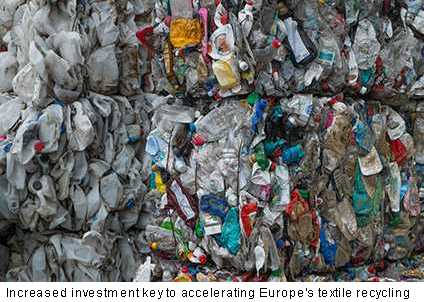
Category: General
Country: United Kingdom
As fibre-to-fibre textile recycling commitments increase across Europe, as well as the amount of textile waste collected, the infrastructure required to drive the move towards circular systems requires significant investment to scale.
By Michelle Russell September 27, 2022.
A report published today (27 September) by global sustainable fashion initiative Fashion for Good details how the amount of textile waste collected across Europe is likely to increase, due to growing consumption and disposal, and incoming legislation, such as the Waste Framework Directive.
Consequently, there is a strong business case for sorting low value textiles in order to maintain and increase sorting capacity in Europe. To support this retention and development of sorting capacity, increased investments and policy changes play a key role.
The report concludes the Sorting for Circularity Europe project, which launched in May last year, and in collaboration with Circle Economy, details the findings of the 16-month analysis.
The project aims to create a greater link between textile sorters and textile recyclers in establishing an infrastructure for greater circularity in the future. It brings together key brands and industry leaders from across Europe to conduct a comprehensive textile waste analysis using more accurate, innovative Near Infrared (NIR) technology, while also mapping textile recycler’s capabilities.
Investing in the value chain
The analysis indicates that 74% – a total of 494,000 tonnes -of low-value, post-consumer textiles is readily available for fibre-to-fibre recycling in six European countries. This represents the potential to generate an additional EUR74m (US$168m) per year in value by reintroducing sorted and recycled textiles back into the value chain.
Using innovative Near Infrared (NIR) technology to determine garment composition, traditionally a task performed manually, the project analysed a total of 21 tonnes of post-consumer garments. On-the-ground examinations were performed over two time periods, autumn/winter 2021 and spring/summer 2022, to account for seasonal changes in the types of garments entering sorting facilities.
Cotton was found to be the dominant fibre (42%), followed by a large presence of material blends (32%), almost half of which consisted of polycottons (12%). Based on three characteristics, material composition, presence of disruptors, such as zippers and buttons, and colour, 21% of the materials analysed are deemed suitable as feedstock for mechanical recycling, while 53% are suitable for chemical recycling.
This, the report suggests, presents a significant opportunity for circularity as currently only 2% of post-consumer textiles are diverted to fibre-to-fibre recycling.
“As fibre-to-fibre textile recycling commitments and policies increase, as well as the amount of textile waste collected, the infrastructure required to drive the move towards circular systems requires significant investment to scale,” says Katrin Ley, managing director at Fashion for Good. “To make informed investment decisions, as well as assess the business case for monetisation through recycling, a deeper understanding of the characteristics of today’s European post-consumer textiles landscape is needed. This project lays the knowledge foundation that will enable key players to set into motion.”
Conducting the analyses across Europe, in Belgium, Germany, the Netherlands, Poland, Spain, and the United Kingdom, the project provides the most comprehensive and representative snapshot of textile waste composition in Europe to date. The results point to promising opportunities for recapturing value while diverting textiles from downcycling and incineration. The results also inform brands of the best circular design practises to adopt, as well as textile collection agencies and organisations to build the necessary infrastructure and better educate and engage consumers on proper sorting and disposal practices.
Path towards a circular industry
According to the report, the amount of textile waste collected is likely to increase, due to growing consumption and disposal, and incoming legislation, such as the Waste Framework Directive. Overall, a strong business case for sorting low value textiles is required in order to maintain and increase sorting capacity in Europe. To support this retention and development of sorting capacity, increased investments and policy changes play a key role.
Based on findings and knowledge gathered from the project, Fashion for Good and Circle Economy recommend the following actions in the report:
For all collectors, sorters, and recyclers
-Use the Sorters Handbook and the Sorting for Circularity Europe Report as guidance to conduct further trials and continue to build an understanding of fibre composition, sorting and recycling processes.
-Provide open-access to trials and data that can support and direct investment into necessary infrastructure.
-Update and utilise the Recyclers Database to build knowledge about mechanical and chemical recycling destinations.
-Funnel further investments into new sorting technologies needed to scale the amount of textiles deemed suitable as feedstock for mechanical and chemical recycling.
-Join digital platforms such as Reverse Resources and Refashion Recycle to unlock and connect supply with demand.
For brands and manufacturers
-Further commit to adopting circular design practices and incorporating recycled fibres into product portfolios as mandated by the upcoming Ecodesign for Sustainable Products Regulation in the European Union.
For policy makers
-Consider the Sorting for Circularity Europe Report and other relevant studies when developing toolkits, frameworks and legislation such as: the harmonised Extended Producer Responsibility framework, the Digital Product Passports pathway in textiles, and the Ecodesign for Sustainable Products Regulation.
For consumers
-Take into account that purchase and disposal choices have an influence on the end of use of textiles. Consider extending the life of products through repairing, reselling and swapping.
Courtesy: https://www.just-style.com/news/increased-investment-key-to-accelerating-europes-textile-recycling/
Copyrights © 2025 GLOBAL TEXTILE SOURCE. All rights reserved.